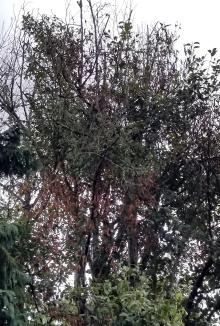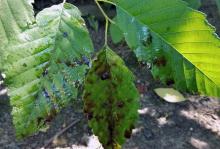Cause Unknown. Diseased tissue is negative for Phytophthora organisms. Many different secondary fungi have been isolated including a Phomopsis sp. The bacteria Lonsdalea sp. has also been isolated from branch cankers. Sequencing placed it close to L. quercina, the cause of a disease known as drippy blight of oaks.
This problem has been observed in the Willamette Valley, mostly near Corvallis, OR since the mid-2000s on a few urban landscape trees. Although symptoms are noticed after summer heat stress, dripping cankers occur prior to those events. Winter sun scald or summer sun burn may initiate the problem since symptoms seem to occur on the south or southwest side of trees.
Symptoms Trees show canopy dieback and cankers starting on the south or southwest side of trees. Branches that are girdled or die during the summer retain brown dead leaves for extended periods. Cankers occur on all sizes branches and trunks. Cankers and dead braches exude a dark brown liquid throughout the year bleeding down the trunk. Anything under these trees gets covered with sticky, brown to dark brown spots or puddles of smelly ooze. Trees may not die for many years but continue to experience different degrees of dieback each year always oozing liquid.
Cultural control None known but it is suggested to remove dead braches and cankers well below the weeping areas. Whole tree removal may be necessary in advanced cases.
References Sitz, R. A., Aquino, V. M., Tisserat, N. A., Cranshaw, W. S. and Stewart, J. E. 2019. Insects visiting drippy blight diseased red oak trees are contaminated with the pathogenic bacterium Lonsdalea quercina. Plant disease, 103:1940-1946.



